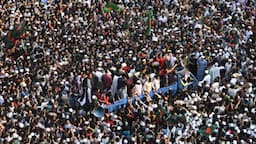In what seems to be a targeted attack at militant group Hezbollah, the wireless communication devices they use detonated killing at least nine people and injuring nearly 3,000 others.
The incident happened on Sep 17 when the wave of explosions lasted for about an hour. According to a Reuters report, the detonations started around 3:30 pm (1230 GMT) in the southern suburbs of Beirut known as Dahiyeh and the eastern Bekaa valley which are strongholds of Hezbollah.

Some of the detonations took place after the pagers rang which caused fighters to put their hands on them or bring them up to their faces to check the screens, it said.
As many as 5,000 pagers from Taiwan-based Gold Apollo were ordered by the Iran-backed group months before the blasts.
However, the company said that it did not manufacture the devices and a company called BAC which has a license to use its brand had manufactured the device but gave no more details.
Although diplomatic and security sources speculated the explosions could have been caused by devices' overheated batteries, other experts doubted this possibility and blamed Israel for the incident.
Both Lebanon and Hezbollah have also blamed Israel's spy agency, Mossad, for the explosions. Many reports have also suggested that they planted a small amount of explosives inside the Taiwan-made pagers five months before.
However, Tel Aviv has not yet responded to the charges.
Iran-backed Hezbollah is actively engaged in cross-border warfare with Israel, especially since the Gaza war began in October last year.
To prevent Israeli breaches, the group avoided mobile phones and instead relied on its telecommunications system. They used pagers — a small, portable communication device that receives short messages, typically numeric or alphanumeric over a radio frequency signal — as it is most efficient even in remote areas and could evade Israeli location-tracking.
Since the killing of senior commanders in targeted Israeli airstrikes, Hezbollah has been using some low-tech devices, including landline phones and pagers, to try to escape Israel's sophisticated surveillance technology.
The group also uses its drones to research and attack Israel's intelligence, a strategy that the group's leader, Sayyed Hassan Nasrallah, described as "blinding" Israel.
Israel on the other hand, uses hi-tech security cameras and remote sensing systems to identify and strike down its targets in enemy territory.
Meanwhile, Hezbollah has affirmed that it will carry investigation into the cause of the blasts, warning Israel of receiving “its fair punishment.”

The incident comes amid heightened tensions between Lebanon and Israel. On July 30, the Israeli forces struck a building in southern Beirut, killing the Lebanese militant group Hezbollah’s most senior military commander Fuad Shukr.
Hezbollah and Israeli forces have been exchanging fire almost daily since the war between Israel and Hamas in Gaza. Hundreds have been killed in Lebanon and dozens in Israel, while many have been displaced on both sides of the border.
It is widely believed that Israel previously killed Hamas militants with booby-trapped cell phones and was also behind the Stuxnet computer virus attack on Iran’s nuclear program in 2010.

















